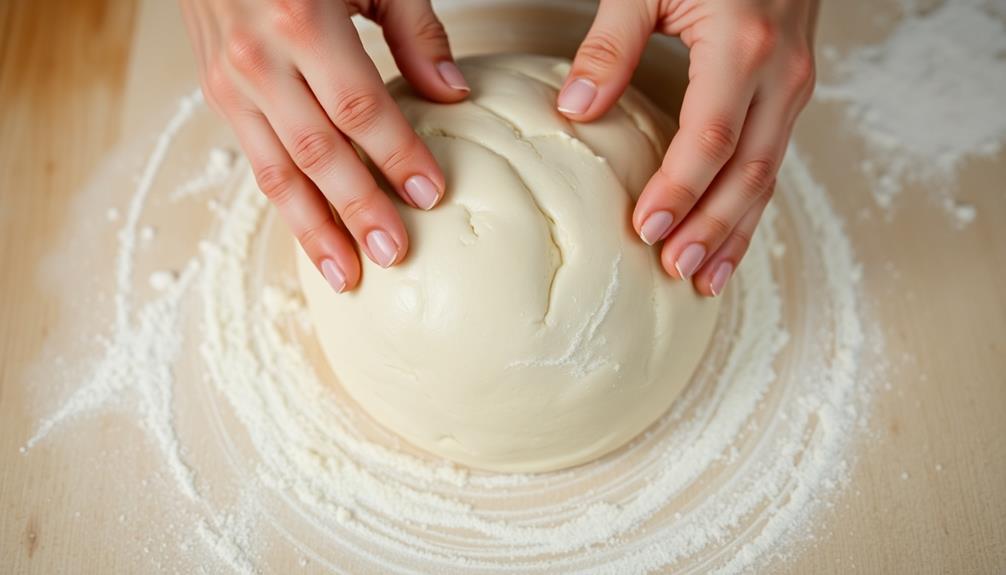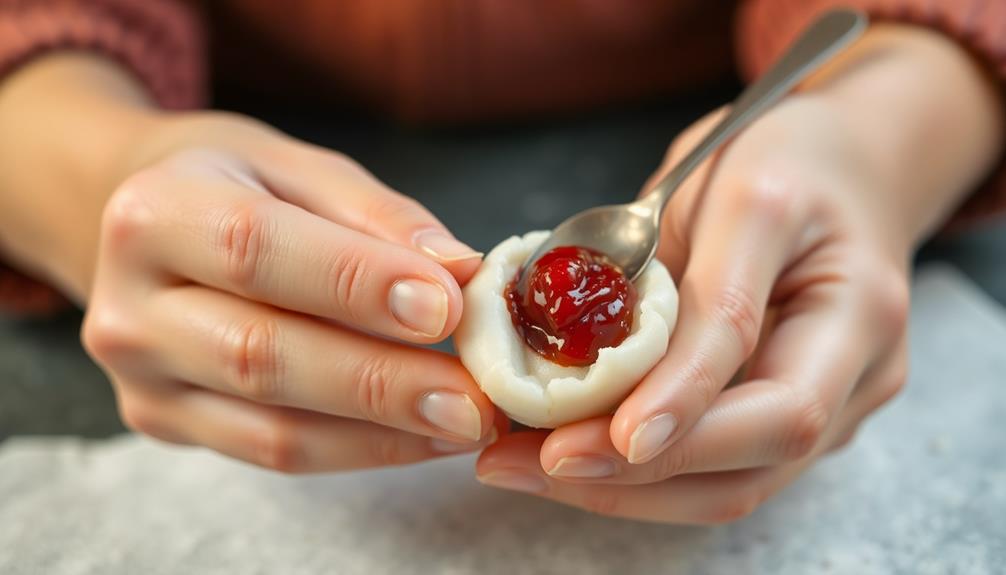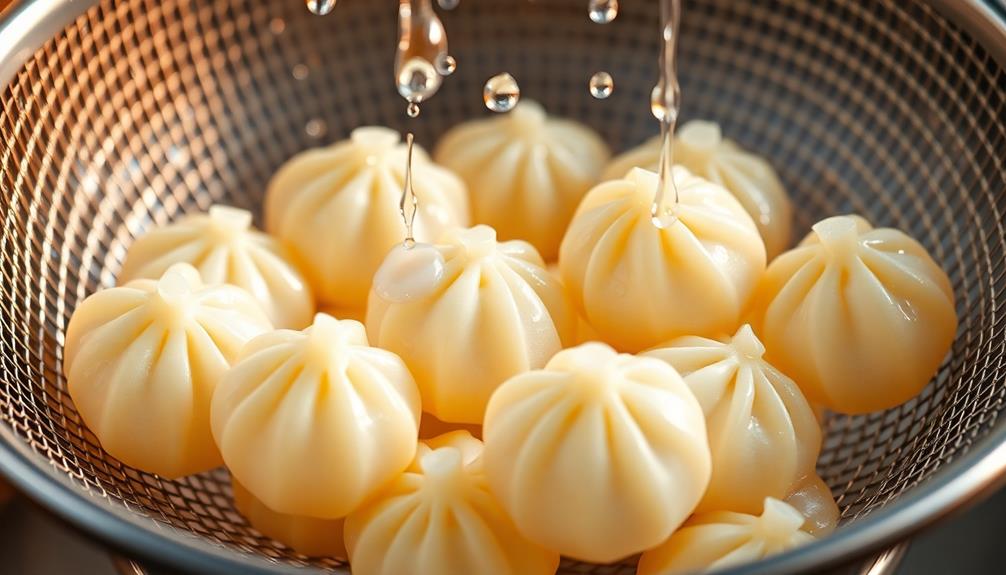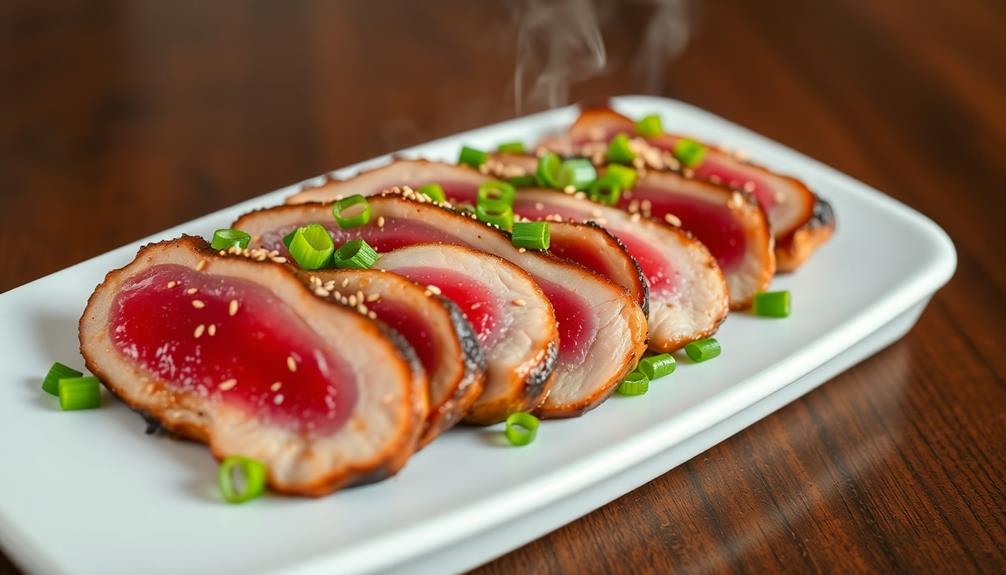Tangyuan, the chewy glutinous rice balls, have delighted Chinese families for centuries! These festive treats originated during the Tang Dynasty to honor the winter solstice. Today, they're enjoyed year-round, symbolizing unity and togetherness. To make them, you'll knead together glutinous rice flour and warm water, then stuff the dough with tasty fillings like red bean paste. Boil the filled balls until they float, then serve them warm in broth or drizzled with a sweet syrup. Customize them with toppings like sesame seeds for extra flavor and flair. Making tangyuan is a fun family activity – so get ready to roll up your sleeves and create these cherished Chinese delights!
Key Takeaways
- Tangyuan is a traditional Chinese dessert made from glutinous rice flour, with origins dating back to the Tang Dynasty.
- They are typically enjoyed during the Lantern Festival, representing unity and togetherness in Chinese culture.
- The dough is shaped into balls, with various fillings like red bean paste, and then boiled until they float to the surface.
- Tangyuan can be served in warm broth, drizzled with syrup, or garnished with toasted sesame seeds for added flavor and texture.
- Crafting tangyuan can be a fun family activity that promotes bonding and the passing down of culinary traditions.
History
Tangyuan, a beloved Chinese delicacy, has a rich history dating back centuries. These chewy, round glutinous rice balls are a traditional food enjoyed during the Lantern Festival, a joyous celebration that marks the end of the Lunar New Year. The name "tangyuan" literally means "round balls in soup," and this tasty treat has been a beloved part of Chinese culture for generations.
The origins of tangyuan can be traced back to the Tang Dynasty, when these delightful dumplings were first created and served to honor the winter solstice.
Over the centuries, the recipe and preparation methods have evolved, with different regions developing their own unique variations.
Today, tangyuan come in a wide array of flavors, from classic sweet fillings to savory options, making them a versatile and beloved part of Chinese cuisine.
Recipe
Tangyuan, also known as glutinous rice balls, are a traditional Chinese dessert enjoyed for their soft, chewy texture and sweet flavors. These delightful treats are often served during special occasions, such as the Lantern Festival, to symbolize togetherness and unity.
The process of making tangyuan may seem daunting, but with a few simple steps, you can create these delectable morsels in the comfort of your own kitchen. Whether you prefer a classic sweet filling or a more adventurous flavor, this recipe will guide you through the process to achieve the perfect tangyuan.
Ingredients:
- 1 cup (120g) glutinous rice flour
- 1/4 cup (60ml) warm water
- Filling of your choice (e.g., sweetened red bean paste, black sesame paste, or chopped peanuts)
Cooking Instructions:
In a large mixing bowl, combine the glutinous rice flour and warm water. Knead the mixture until a smooth, pliable dough forms.
Cover the dough with a damp cloth and let it rest for 30 minutes. Divide the dough into small, equal-sized balls, about 1 inch (2.5 cm) in diameter. Using your thumb, create an indent in the center of each ball and fill it with your desired filling.
Gently pinch the dough around the filling to seal it completely. Bring a large pot of water to a boil, and carefully drop the filled tangyuan into the boiling water. Cook for 5-7 minutes, or until the tangyuan float to the surface.
When cooking tangyuan, it's important to use freshly made glutinous rice flour for the best texture. Additionally, be gentle when handling the dough to prevent the filling from leaking.
Serve the cooked tangyuan warm, either with a sweet broth or drizzled with a syrup of your choice, such as honey or brown sugar. The delicate texture of the tangyuan pairs beautifully with the subtle sweetness, making it a comforting dessert or snack. For a complete spread, consider serving alongside savory dishes that complement the flavors, such as dumplings or a tried-and-true **steamed pork buns recipe**. The balance of sweet and savory elements will create a memorable, harmonious meal perfect for any occasion.
Cooking Steps
Alright, let's get started on those tangyuan!
First, you'll need to knead the dough until it's smooth and easy to work with.
Next, fill the dough with your favorite filling.
Then, simply pop those little balls into some boiling water and let 'em cook until they float to the top.
Don't forget to give them a good drain before serving, and you can even sprinkle on some sesame seeds for a tasty finishing touch!
Step 1. Knead Dough Until Smooth and Pliable

How do you go about kneading the dough until it's smooth and pliable? First, make sure your work surface is clean and lightly dusted with flour.
Then, take a big ol' lump of that glutinous rice dough and start pressing and folding it over itself. Use the heels of your hands to really work it, pushing and squeezing until the dough becomes silky smooth.
Don't be shy – put some muscle into it! As you knead, the dough will gradually transform from lumpy and sticky to soft and supple.
You'll know it's ready when you can easily shape it into a ball without it cracking or falling apart. Once it reaches this perfect, pliable state, you're one step closer to making those delightful little tangyuan!
Just remember to keep kneading with confidence, and don't be afraid to get your hands a little messy. It's all part of the fun.
Step 2. Fill Dough With Desired Filling

Once you've kneaded the dough to a smooth, supple texture, it's time to start filling your tangyuan.
Grab a small piece of the dough and roll it into a ball about the size of a ping-pong ball. Use your thumb to make an indentation in the center, creating a little cup.
Now, spoon a teaspoon or so of your favorite filling into the dough cup. Maybe you'll choose a sweet red bean paste or a savory pork and vegetable mixture.
Gently pinch the dough around the filling, sealing it inside. Roll the filled dough ball between your palms to smooth it out, being careful not to crack the surface.
Repeat this process until you've used up all your dough. Aren't these little dumplings fun to make?
The possibilities for fillings are endless, so get creative and fill them with your preferred flavors. Just wait until you take that first delightful bite!
Step 3. Cook in Boiling Water

With the tangyuan dumplings filled, you'll need to cook them in boiling water. First, bring a large pot of water to a rolling boil.
Once the water is at a full boil, gently drop the filled tangyuan into the pot. They'll sink to the bottom at first, but don't worry – they'll start floating back up to the surface as they cook. Let them simmer for 5-8 minutes, until they're completely cooked through.
The tangyuan are done when they're floating on top and their exteriors look glossy and translucent.
Use a slotted spoon to carefully transfer the cooked tangyuan to a serving bowl. Be gentle, as the dumplings can be delicate.
You can serve the tangyuan warm in the broth, or drain them and serve them plain. They're delicious either way! The sweet, chewy texture of the glutinous rice balls pairs perfectly with the savory or sweet fillings.
Enjoy your homemade tangyuan!
Step 4. Drain Cooked Tangyuan From Water

When the tangyuan have finished simmering for 5-8 minutes and are floating on top of the water, you'll want to carefully remove them from the pot.
Using a slotted spoon or strainer, gently scoop out the cooked tangyuan and transfer them to a serving bowl or plate. Be extra cautious, as the little rice balls will be hot!
Once they're out of the water, you can give them a quick rinse under cold running water. This will stop the cooking process and help the tangyuan retain their soft, delicate texture.
Gently shake or pat them dry with a paper towel, then they're ready to serve!
Tangyuan are delightful when enjoyed warm, so try to work quickly to get them from the pot to the table.
You can top them with a drizzle of sweet syrup, sprinkle on some toasted sesame seeds, or simply savor them plain.
No matter how you serve them, these chewy, flavorful rice balls are sure to be a hit!
Step 5. Garnish With Sesame Seeds, if Desired

If desired, you can garnish the drained and cooled tangyuan with a sprinkling of toasted sesame seeds. The nutty, crunchy texture of the sesame seeds provides a delightful contrast to the soft, chewy glutinous rice balls. For an extra burst of flavor and color, you can also drizzle a small amount of sweetened condensed milk over the tangyuan. This will add a creamy richness to the dessert that complements the sesame seeds perfectly. If you’re looking for more traditional Chinese recipes, you might want to try making a classic noodles recipe with bean sauce. This savory dish is a popular staple in Chinese cuisine and is often served as a main course or as a side dish.
Simply pour a small amount of sesame seeds into your palm and gently sprinkle them over the tangyuan. The seeds will lightly adhere to the surface, adding a visually appealing and tasty finishing touch.
For maximum flavor, you can toast the sesame seeds in a dry skillet over medium heat, stirring frequently, until they're lightly golden and fragrant. This extra step brings out the natural oils and enhances the nutty aroma.
Be careful not to let them burn, as that can create a bitter taste. Once toasted, the sesame seeds are ready to elevate your tangyuan to the next level of deliciousness.
Feel free to add as much or as little as you like, depending on your personal preference.
Final Thoughts
Ultimately, tangyuan are a comforting and delightful treat that can elevate any occasion. The soft, chewy texture and sweet, earthy flavors make them a beloved dessert, while their festive appearance adds a touch of whimsy to any gathering.
Whether you're celebrating a special event or simply craving a cozy, indulgent snack, these glutinous rice balls are sure to hit the spot.
What makes tangyuan so special is their versatility. You can serve them warm or chilled, dress them up with toppings like sesame seeds, or even experiment with different fillings.
And let's not forget the fun of making them yourself, getting your hands a little messy as you shape the dough into perfect little spheres. It's a delightful activity that the whole family can enjoy.
Frequently Asked Questions
What Is the Significance of Tangyuan During Chinese Festivals?
During Chinese festivals, tangyuan holds deep cultural significance. It symbolizes reunion, completeness, and a yearning for harmony. This cherished tradition brings families together, fostering a sense of belonging and celebrating the joyous occasions that define Chinese heritage.
How Long Can Tangyuan Be Stored After Cooking?
Cooked tangyuan can be stored for up to 3 days in the refrigerator. However, they'll lose their soft, chewy texture the longer they're kept. For best results, enjoy your tangyuan fresh on the day they're made.
Can Tangyuan Be Frozen and Reheated?
You can absolutely freeze and reheat cooked tangyuan. Just let them cool completely, then pop them in the freezer. When you're ready to enjoy, reheat in the microwave or boiling water until heated through. Easy peasy!
Are There Any Health Benefits Associated With Tangyuan?
There are some potential health benefits to eating tangyuan. They're made with glutinous rice flour, which contains complex carbohydrates that can provide sustained energy. Additionally, the fillings often include nutritious ingredients like red bean or sesame paste.
Where Can I Purchase Pre-Made Tangyuan in My Local Area?
You can find pre-made tangyuan at Asian grocery stores or specialty markets in your local area. Many Chinese supermarkets and international food shops will carry this popular glutinous rice dessert in the frozen section.









